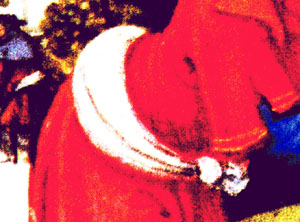
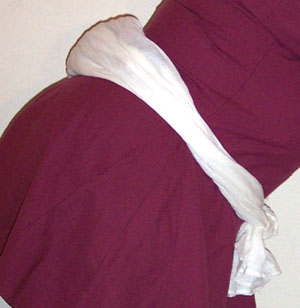
Main Menu - Misc. - Clothing/Textiles - Medieval Wales - Names - Other Medieval - Publications - Harpy Publications
Return to main page


The sash style is the easiest to be confident in interpreting. Take a rectangle of medium-weight linen, long enough go go around the waist and tie in a square knot, plus a few inches extra to accomodate the contents, and wide enough to go one and a half times or twice around whatever contents are intended. The one I experimented with was 24" x 75". It behaves and looks very much like the "ambiguous" sash-type examples, such as Bibl. Nat. Paris MS 42 or the Grande Heures of Anne of Brittany, but doesn't work if there is slack in the sash, as shown in the Playfair Book of Hours or the Rouen Hours. The more "slack" sashes, like the item shown in the Pursuit of St. Barbara, seem either to involve a cloth tucked under a separate belt, or one of the closed styles discussed under the Crescent style.
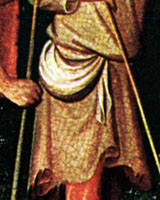
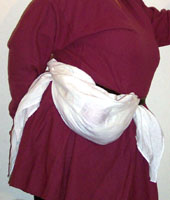
To experiment with the latter group, I used a linen square roughly a yard on a side. Somewhat to my surprise, the St. Barbara style is reasonably stable and secure, as long as the cloth is tucked under a snug belt. I started out by folding the cloth on the diagonal with several objects inside and folding the central corners over to hold things in place, then ran the folded corners under the belt from above (as the painting appears to show). By adjusting the cloth, an open sack can be formed that can be accessed while worn and yet holds a significant amount of contents securely. It's questionable how well it would hold up to vigorous activity, though.
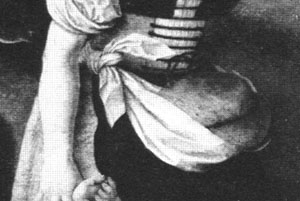
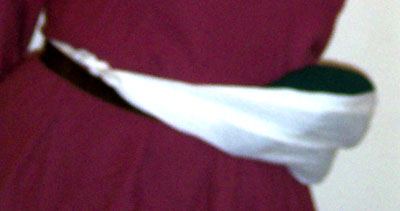
The same cloth (ca. 36" square) can be used similarly to the Abraham and Hagar picture, by placing the contents in the center of the cloth, folding two opposite corners over it, and then tying the remaining corners around the waist. This method, however, is somewhat less stable than the above, and would not work well with small, slippery objects. (For example, it would work better with bread than with apples.)
The crescent-shaped style could reasonably have evolved from either type (i.e., either the sash or the folded square), and there are examples that appear to be transitional in style from both versions. For example. the Playfair Hours and Rouen Hours examples look more as if they came from a folded square, while the de Beer adoration looks more like it evolved from (or still is) a sash. The following picture shows the same cloth as the Abraham and Hagar experiment but more closely rolled around the contents before tying, to more closely resemble a "transitional crescent" shape.

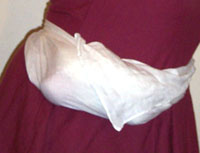
Previous --------------------------------------------- Main --------------------------------------------- Next
This site belongs to Heather Rose Jones. Contact me regarding anything beyond personal, individual use of this material.
Unless otherwise noted, all contents are copyright by Heather Rose Jones, all rights reserved.